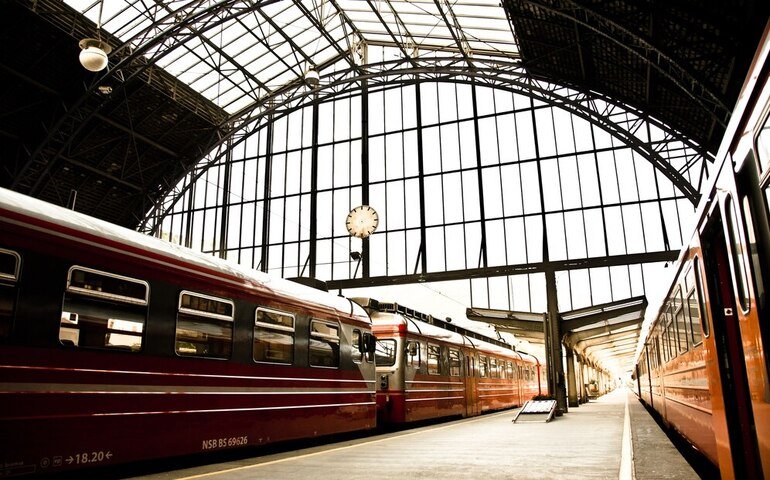Course Features
Price
Study Method
Online | Self-paced
Course Format
Reading Material - PDF, article
Duration
5 hours, 5 minutes
Qualification
No formal qualification
Certificate
At completion
Additional info
Coming soon
- Share
Overview
"Railway Age in Glasgow" takes you on a journey through the significant role that railways have played in shaping Glasgow's history and development. Starting with an introduction to the course and the overall objectives, this course dives deep into how the railway system became integral to the city's social, economic, and cultural fabric. It examines how railways were not only a technological advancement but also a catalyst for change, influencing everything from urbanization to the city's industrial growth.
The course begins by exploring the origins of railways in Glasgow, detailing the early railway lines and their initial purposes. You will learn about the key entrepreneurs and figures behind the development of Glasgow's railway system, setting the stage for the city's broader transportation network. The expansion and integration of Glasgow’s railway system with the rest of the UK is a crucial part of this story, with lessons focusing on the challenges and opportunities faced during this period of rapid growth.
In addition to the social and economic impacts, the course highlights the architectural and engineering marvels that emerged as part of Glasgow's railway infrastructure. Iconic stations and innovative techniques are examined, showcasing how the railways left a lasting imprint on Glasgow’s urban landscape. The Industrial Revolution is another major theme, with lessons discussing how railways facilitated the transportation of goods and raw materials, helping Glasgow thrive as a hub for industry and trade.
The course also looks at the cultural changes spurred by the railway system, including shifts in travel patterns and the rise of commuter culture. Additionally, it delves into how railways influenced leisure, tourism, and even art and literature in Glasgow. As the city’s railway system entered a period of decline, the course explores the factors behind this decline and the subsequent efforts to preserve and revitalize the city’s railway heritage.
Finally, "Railway Age in Glasgow" concludes by reflecting on the legacy of the railway system in Glasgow and its future prospects. Preservation efforts and potential developments are discussed, offering insight into how the railways continue to shape Glasgow’s transportation landscape today.
Who is this course for?
"Railway Age in Glasgow" takes you on a journey through the significant role that railways have played in shaping Glasgow's history and development. Starting with an introduction to the course and the overall objectives, this course dives deep into how the railway system became integral to the city's social, economic, and cultural fabric. It examines how railways were not only a technological advancement but also a catalyst for change, influencing everything from urbanization to the city's industrial growth.
The course begins by exploring the origins of railways in Glasgow, detailing the early railway lines and their initial purposes. You will learn about the key entrepreneurs and figures behind the development of Glasgow's railway system, setting the stage for the city's broader transportation network. The expansion and integration of Glasgow’s railway system with the rest of the UK is a crucial part of this story, with lessons focusing on the challenges and opportunities faced during this period of rapid growth.
In addition to the social and economic impacts, the course highlights the architectural and engineering marvels that emerged as part of Glasgow's railway infrastructure. Iconic stations and innovative techniques are examined, showcasing how the railways left a lasting imprint on Glasgow’s urban landscape. The Industrial Revolution is another major theme, with lessons discussing how railways facilitated the transportation of goods and raw materials, helping Glasgow thrive as a hub for industry and trade.
The course also looks at the cultural changes spurred by the railway system, including shifts in travel patterns and the rise of commuter culture. Additionally, it delves into how railways influenced leisure, tourism, and even art and literature in Glasgow. As the city’s railway system entered a period of decline, the course explores the factors behind this decline and the subsequent efforts to preserve and revitalize the city’s railway heritage.
Finally, "Railway Age in Glasgow" concludes by reflecting on the legacy of the railway system in Glasgow and its future prospects. Preservation efforts and potential developments are discussed, offering insight into how the railways continue to shape Glasgow’s transportation landscape today.
Requirements
"Railway Age in Glasgow" takes you on a journey through the significant role that railways have played in shaping Glasgow's history and development. Starting with an introduction to the course and the overall objectives, this course dives deep into how the railway system became integral to the city's social, economic, and cultural fabric. It examines how railways were not only a technological advancement but also a catalyst for change, influencing everything from urbanization to the city's industrial growth.
The course begins by exploring the origins of railways in Glasgow, detailing the early railway lines and their initial purposes. You will learn about the key entrepreneurs and figures behind the development of Glasgow's railway system, setting the stage for the city's broader transportation network. The expansion and integration of Glasgow’s railway system with the rest of the UK is a crucial part of this story, with lessons focusing on the challenges and opportunities faced during this period of rapid growth.
In addition to the social and economic impacts, the course highlights the architectural and engineering marvels that emerged as part of Glasgow's railway infrastructure. Iconic stations and innovative techniques are examined, showcasing how the railways left a lasting imprint on Glasgow’s urban landscape. The Industrial Revolution is another major theme, with lessons discussing how railways facilitated the transportation of goods and raw materials, helping Glasgow thrive as a hub for industry and trade.
The course also looks at the cultural changes spurred by the railway system, including shifts in travel patterns and the rise of commuter culture. Additionally, it delves into how railways influenced leisure, tourism, and even art and literature in Glasgow. As the city’s railway system entered a period of decline, the course explores the factors behind this decline and the subsequent efforts to preserve and revitalize the city’s railway heritage.
Finally, "Railway Age in Glasgow" concludes by reflecting on the legacy of the railway system in Glasgow and its future prospects. Preservation efforts and potential developments are discussed, offering insight into how the railways continue to shape Glasgow’s transportation landscape today.
Career path
"Railway Age in Glasgow" takes you on a journey through the significant role that railways have played in shaping Glasgow's history and development. Starting with an introduction to the course and the overall objectives, this course dives deep into how the railway system became integral to the city's social, economic, and cultural fabric. It examines how railways were not only a technological advancement but also a catalyst for change, influencing everything from urbanization to the city's industrial growth.
The course begins by exploring the origins of railways in Glasgow, detailing the early railway lines and their initial purposes. You will learn about the key entrepreneurs and figures behind the development of Glasgow's railway system, setting the stage for the city's broader transportation network. The expansion and integration of Glasgow’s railway system with the rest of the UK is a crucial part of this story, with lessons focusing on the challenges and opportunities faced during this period of rapid growth.
In addition to the social and economic impacts, the course highlights the architectural and engineering marvels that emerged as part of Glasgow's railway infrastructure. Iconic stations and innovative techniques are examined, showcasing how the railways left a lasting imprint on Glasgow’s urban landscape. The Industrial Revolution is another major theme, with lessons discussing how railways facilitated the transportation of goods and raw materials, helping Glasgow thrive as a hub for industry and trade.
The course also looks at the cultural changes spurred by the railway system, including shifts in travel patterns and the rise of commuter culture. Additionally, it delves into how railways influenced leisure, tourism, and even art and literature in Glasgow. As the city’s railway system entered a period of decline, the course explores the factors behind this decline and the subsequent efforts to preserve and revitalize the city’s railway heritage.
Finally, "Railway Age in Glasgow" concludes by reflecting on the legacy of the railway system in Glasgow and its future prospects. Preservation efforts and potential developments are discussed, offering insight into how the railways continue to shape Glasgow’s transportation landscape today.
-
- Overview of the course and its objectives 00:10:00
- Introduction to the significance of the railway system in Glasgow’s 00:10:00
- The social, economic, and cultural impact of the railway on the city 00:10:00
-
- Origins of railways in Glasgow 00:10:00
- The first railway lines and their purpose 00:10:00
- Key figures and entrepreneurs involved in early railway development 00:10:00
- Expansion of the railway network in Glasgow 00:10:00
- Integration of Glasgow’s railway system with other regions 00:10:00
- Challenges and opportunities faced during the expansion phase 00:10:00
- The role of railways in the Industrial Revolution 00:10:00
- Transportation of goods and raw materials 00:10:00
- Impact on industrial growth and trade in Glasgow 00:10:00
- Factors contributing to the decline of Glasgow’s railway system 00:10:00
- Efforts to preserve and restore historic railway infrastructure 00:10:00
- Efforts to preserve and restore historic railway infrastructure 00:10:00
- Exam of Railway Age in Glasgow 00:50:00

No Reviews found for this course.
Is this certificate recognized?
Yes, our premium certificate and transcript are widely recognized and accepted by embassies worldwide, particularly by the UK embassy. This adds credibility to your qualification and enhances its value for professional and academic purposes.
I am a beginner. Is this course suitable for me?
Yes, this course is designed for learners of all levels, including beginners. The content is structured to provide step-by-step guidance, ensuring that even those with no prior experience can follow along and gain valuable knowledge.
I am a professional. Is this course suitable for me?
Yes, professionals will also benefit from this course. It covers advanced concepts, practical applications, and industry insights that can help enhance existing skills and knowledge. Whether you are looking to refine your expertise or expand your qualifications, this course provides valuable learning.
Does this course have an expiry date?
No, you have lifetime access to the course. Once enrolled, you can revisit the materials at any time as long as the course remains available. Additionally, we regularly update our content to ensure it stays relevant and up to date.
How do I claim my free certificate?
I trust you’re in good health. Your free certificate can be located in the Achievement section. The option to purchase a CPD certificate is available but entirely optional, and you may choose to skip it. Please be aware that it’s crucial to click the “Complete” button to ensure the certificate is generated, as this process is entirely automated.
Does this course have assessments and assignments?
Yes, the course includes both assessments and assignments. Your final marks will be determined by a combination of 20% from assignments and 80% from assessments. These evaluations are designed to test your understanding and ensure you have grasped the key concepts effectively.
Is this course accredited?
We are a recognized course provider with CPD, UKRLP, and AOHT membership. The logos of these accreditation bodies will be featured on your premium certificate and transcript, ensuring credibility and professional recognition.
Will I receive a certificate upon completion?
Yes, you will receive a free digital certificate automatically once you complete the course. If you would like a premium CPD-accredited certificate, either in digital or physical format, you can upgrade for a small fee.
Course Features
Price
Study Method
Online | Self-paced
Course Format
Reading Material - PDF, article
Duration
5 hours, 5 minutes
Qualification
No formal qualification
Certificate
At completion
Additional info
Coming soon
- Share
GP - Clinical Governance
Course Line238₩900,715.06Original price was: ₩900,715.06.₩27,554.53Current price is: ₩27,554.53.Butchery Level 8 Advanced Diploma
Course Line238₩900,715.06Original price was: ₩900,715.06.₩27,554.53Current price is: ₩27,554.53.Cognitive Behavioral Therapy (CBT) for Overcoming Anxiety and Depression
Course Line237₩900,715.06Original price was: ₩900,715.06.₩27,554.53Current price is: ₩27,554.53.
Related Courses
Director of Football Level 2: Player and Staff Management
₩900,715.06Original price was: ₩900,715.06.₩27,554.53Current price is: ₩27,554.53. 240
240Pregnancy Massage Level 5 Advanced Diploma
₩900,715.06Original price was: ₩900,715.06.₩27,554.53Current price is: ₩27,554.53. 237
237Football Coaching Level 6 Advanced Diploma
₩900,715.06Original price was: ₩900,715.06.₩27,554.53Current price is: ₩27,554.53. 239
239
Related Courses
Director of Football Level 2: Player and Staff Management
₩900,715.06Original price was: ₩900,715.06.₩27,554.53Current price is: ₩27,554.53. 240
240Pregnancy Massage Level 5 Advanced Diploma
₩900,715.06Original price was: ₩900,715.06.₩27,554.53Current price is: ₩27,554.53. 237
237Football Coaching Level 6 Advanced Diploma
₩900,715.06Original price was: ₩900,715.06.₩27,554.53Current price is: ₩27,554.53. 239
239








